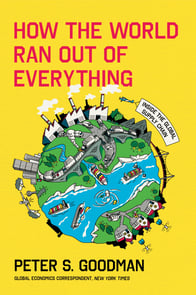 How the World Ran Out of Everything
How the World Ran Out of Everything
Peter S. Goodman
Mariner Books
New York and Boston, 2024, 406 pp., $37
Until its dramatic collapse, most people barely knew that something called the global supply chain existed, much less understood how much their daily lives depended on it. Then, suddenly, toilet paper and frozen chicken disappeared from supermarket shelves, and COVID-19 patients were left dying in hospitals for lack of medical equipment. How could it have happened?
Enter Peter S. Goodman, veteran economics reporter for the New York Times, who chronicled the unfolding disaster at close quarters, from the factories of Shenzhen, China, to the ports of Los Angeles and Long Beach and the truck stops and rail yards of Middle America. His reporting forms the heart of this new book, How the World Ran Out of Everything.
Goodman’s gift for storytelling and eye for vivid detail breathe life into an inherently arcane subject. His story follows the travails of one Hagan Walker, an entrepreneur who struggles to have an order of plastic toys shipped from a factory in China to customers in the United States in time for the holiday shopping season. (I won’t reveal how the journey ended.)
Along the way, we meet a host of minor characters whose lives were upended by the pandemic and resulting economic fallout: sailors marooned aboard an idle container ship, a California farmer who cannot deliver his almonds to customers in the Middle East, and a railroad worker who is refused paid leave to care for a sick child.
Goodman widens his lens to deliver pithy accounts of the forces that propelled globalization. These include the economic reforms that unleashed China’s export-led economic transformation; the invention of the shipping container, which dramatically reduced the time and expense of moving goods across oceans; and the concept of just-in-time manufacturing, which, taken to extremes, made the world more vulnerable to supply-chain disruptions, Goodman argues.
There are villains, too, including management consultants who counseled their corporate clients to slash inventories and payrolls in the name of lean manufacturing. The archvillain, however, is the “investor class,” whose relentless pursuit of profit comes at the expense of consumers and workers.
Some of Goodman’s reporting is truly moving, such as his description of the horrific conditions in meat-packing plants that were declared essential during the pandemic, leading to the needless deaths of many workers, including an immigrant from Myanmar who didn’t live to see her grandchild born. Yet these stories are marred by somewhat tedious denunciations of “unregulated greed” and “cold-blooded exploitation.”
The final chapters offer a quick survey of efforts at re-shoring and near-shoring. But the book ends on a pessimistic note, given that in Goodman’s analysis, the root of the problem lies in the pursuit of profit. Goodman stops short of advocating the abolition of capitalism. Instead, his somewhat perfunctory conclusion calls for stricter antitrust enforcement and stronger labor unions. Nevertheless, his book offers a gripping and enlightening account of one of the most consequential economic events of modern times, told through the eyes of the people caught up in it.
Opinions expressed in articles and other materials are those of the authors; they do not necessarily reflect IMF policy.








